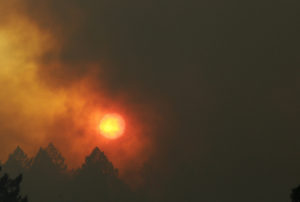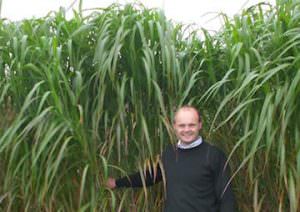Cutting Warming to 1.5°C Could Endanger Food Supply
Scientists say meeting the tougher demands of many countries on limiting global temperature rise may be technically feasible, but would risk worsening world hunger.
By Alex Kirby, Climate News Network

Increased planting of crops such as rapeseed for biofuel production could affect food security. (Myrabella via Wikimedia Commons)
This Creative Commons-licensed piece first appeared at Climate News Network.
LONDON — As world leaders try to agree how to prevent global warming from heating the planet by more than 2°C above pre-industrial levels, scientists have tackled an altogether thornier question: can we keep the rise below 1.5°C?
The lower target — demanded by more than 100 countries as a safer goal — is attainable, they say. But there will be little room for error, and getting there will mean not only cutting greenhouse gas emissions, but actually removing carbon dioxide from the atmosphere.
That is not possible with the technology now available. And even if it could one day be done, it would probably have forbiddingly harmful consequences for world food supplies.
However, limiting temperature rise by 2100 to less than 1.5°C is still feasible, say the researchers from the International Institute for Applied Systems Analysis (IIASA) in Austria, the Potsdam Institute for Climate Impact Research (PIK), Germany, and colleagues. They report their findings in the journal Nature Climate Change.
Similar actions
Not surprisingly, the answer includes doing more, and doing it faster. “Actions for returning global warming to below 1.5°C by 2100 are in many ways similar to those for limiting warming to below 2°C,” says IIASA climate researcher Joeri Rogelj, one of the lead authors of the report.
The authors accept that the economic, political, and technological conditions for achieving even 2°C are “substantial”. The negotiations to be held in Paris in December by member states of the UN Framework Convention on Climate Change (UNFCCC) may show what chance there is of meeting them.
The new study identifies key ways of reaching the 1.5°C target by 2100. One is a tight limit on future carbon emissions.
Gunnar Luderer, PIK senior researcher in sustainable solutions, who co-led the study, says: “In 1.5°C scenarios, the remaining carbon budget for the 21st century is reduced to almost half, compared to 2°C scenarios.
“As a consequence, deeper emissions cuts are required from all sectors, and global carbon neutrality would need to be reached 10-20 years earlier than projected for 2°C scenarios.”
Energy efficiency will also need to improve faster, he says.
“The scenarios we assess keep warming
to the lowest levels currently considered
technologically feasible”
But the study finds that staying below 1.5°C would require a radical step change: some time this century, carbon emissions would have to become negative at a global scale.
That is the scientists’ way of saying that significant amounts of CO2 will have to be actively removed from the atmosphere. And there is at present no known way of doing that.
In theory, it is possible — for example, through bio-energy use, combined with carbon capture and storage. But that is a technology that so far remains untested on a large scale.
It would also increase hunger, as the crops needed to produce enough biofuel would compete for land with food plants.
Another idea is to grow more forests, which would sequester carbon in their trees, but this would be open to the same objection — that it would reduce cropland. The higher temperatures in prospect will themselves affect forest growth and health.
Lowest levels
Rogelj told the Climate News Network: “Increased temperatures can make afforestation efforts harder. However, the scenarios we assess here keep warming to the lowest levels currently considered technologically feasible, and this issue will thus have a relatively smaller impact.”
Whatever happens, the authors expect things to get hotter before they have any chance of cooling down.
Rogelj says: “Basically, all our 1.5°C scenarios first exceed the 1.5°C temperature threshold somewhere in mid-century, before declining to 2100 and beyond as more and more carbon dioxide is actively removed from the atmosphere by specialised technologies.”
Over 100 countries worldwide — more than half the members of the UNFCCC, including the Alliance of Small Island States (AOSIS) and the Least Developed Countries (LDCs) — have declared their support for a 1.5°C target.
Your support is crucial…With an uncertain future and a new administration casting doubt on press freedoms, the danger is clear: The truth is at risk.
Now is the time to give. Your tax-deductible support allows us to dig deeper, delivering fearless investigative reporting and analysis that exposes what’s really happening — without compromise.
Stand with our courageous journalists. Donate today to protect a free press, uphold democracy and unearth untold stories.



You need to be a supporter to comment.
There are currently no responses to this article.
Be the first to respond.